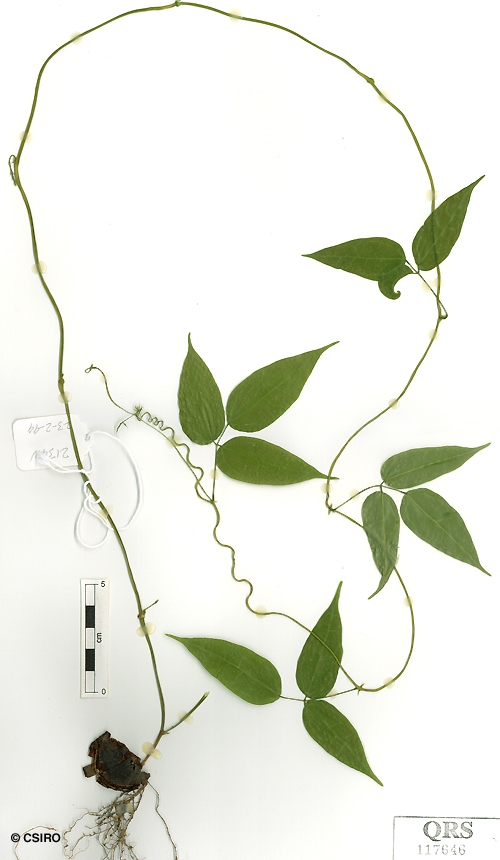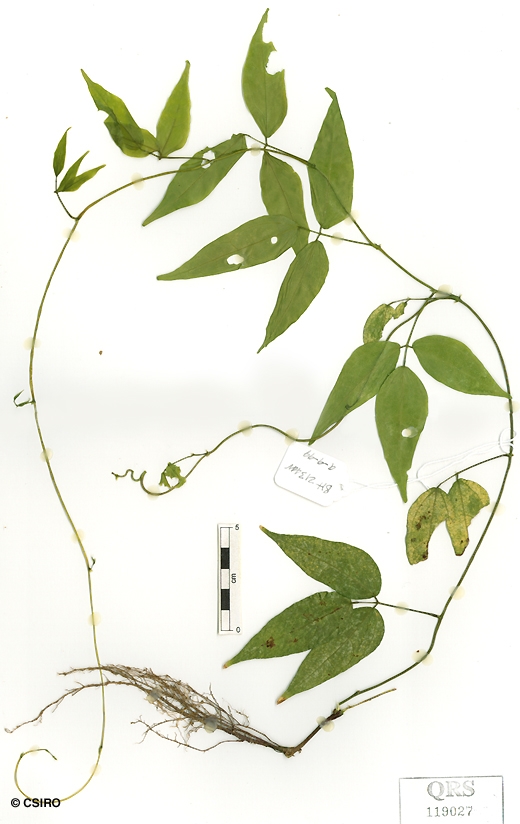Australian Tropical Rainforest Plants - Online edition
Strongylodon lucidus (G.Forst.) Seem.





Seemann, K.O. von (1865) Fl. Vit. : 61.
Pink Strongylodon; Strongylodon, Pink
Leaflet blades about 10.5-13.5 x 5-8 cm, lateral leaflets asymmetrical, the midrib being closer to one side than the other. The three leaflets of similar size and thin in texture. 'Stalk' of the middle leaflet longer than those of the lateral leaflets. Lateral leaflet stalks transversely wrinkled. Lateral veins about 5 on each side of the midrib. Stipules about 6 mm long, longitudinally veined. Stipels about 4-5 mm long.
Racemes up to 25 cm long, pedicels about 15-20 mm long. Calyx cup-shaped, about 7-8 mm long, the lobes about 1 mm long, small and inconspicuous. Petals clawed, standard about 25 x 13-15 mm; wings about half as long as the keel; keel about 25 mm long, +/- encompassing the staminal tube. Stamens 10, the filaments of nine stamens fused to form a tube open on one side. One stamen free. Disk irregular, about 0.8-1 mm high surrounding the base of the ovary. Ovary glabrous, about 3-4 mm long on a stalk about 6-7 mm long. Ovules one or two.
Fruits oblong to ellipsoid, about 5-8 x 2.5-3.5 cm. Seeds ellipsoidal, about 2 x 1.6-1.8 cm, testa extremely hard, flint-like. Funicle extends for about one third of the circumference of the seed. Hilum extending more than halfway around the seed. Cotyledons fused together, not differentiated, finely textured, dry and powdery. Radicle not obvious, much shorter and narrower than the cotyledons.
About 3-6 cataphylls produced before the first true leaves. First leaflet blades glabrous, narrowly ovate, apex acuminate, base obtuse to obliquely cordate. Stipules spreading, about 3.5 mm long. Stipels present. Third and subsequent leaves trifoliolate. At the tenth leaf stage: leaflet blades broadly lanceolate to almost elliptic, apex acuminate, base obtuse and oblique on lateral leaflets. Leaflets +/- three-veined, midrib raised on the upper surface. Stipules +/- cordate, about 2 mm long, venation conspicuous and longitudinal. Stalk of the middle leaflet pulvinate and longer than those on the lateral leaflets. Stipels present. Terminal bud clothed in short translucent hairs and enveloped by stipules. Seed germination time 23 to 30 days.
This climber has great potential in horticulture and produces large inflorescences of bright pink flowers.





